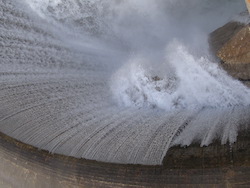SEJournal Online is the digital news magazine of the Society of Environmental Journalists. Learn more about SEJournal Online, including submission, subscription and advertising information.
TipSheet: Dam Safety Issues at Forefront Following Hurricane Flooding
The recent barrage of hurricanes — Harvey, Irma and Maria — provides a stark reminder of how heavy rains can threaten life and property due to failing dams.
Maria inundated the Guajataca Dam in Puerto Rico, destabilizing it in several ways that threatened complete failure, prompting difficult efforts to evacuate at-risk residents amid failed roads and communications.
Irma prompted worries that rising Lake Okeechobee waters could challenge the 143-mile long Herbert Hoover Dike. Some downstream communities at risk of inundation in a failure were evacuated. The dike held.
Harvey dumped more rain on some of the Houston region (over 50 inches) than had ever been recorded in the lower 48. That filled the reservoirs behind the Addicks and Barker dams upstream of Houston, which had been built for the purpose of flood control. To prevent a more catastrophic failure, engineers made the hard choice to release water from the dams, exacerbating flooding in parts of the Houston area.
See a pattern yet? Such events aren’t that unusual. They are often predictable.
Dam failure is something environmental journalists can be ready for and even report about ahead of time. Knowing your local and regional dams may be part of your job as an environmental reporter.
Questions to ask amid reporting challenges
If you start looking into dams, you will find a bewildering array of reporting challenges.
First, questions about dams abound:
- Would lives or property be threatened if they were to fail?
- Are they physically sound?
- When were they last inspected and what was found?
- What are the plans for managing them in a flood?
- Do they have “Emergency Action Plans” for warning and evacuation (some don’t)?
- Who owns them, and who should pay to make them safe? And who will make them do it?
Then there’s the issue of accountability.
Dams may be owned and operated by federal agencies like the U.S. Army Corps of Engineers or the Bureau of Reclamation — but more often they are owned by state agencies and even more often by private entities or landowners whose accountability may be minimal.
 |
| Overflow of the Sun River Diversion Dam in Montana. Photo: Bureau of Reclamation/Joe Rohde |
Even worse is the secrecy, which directly threatens the lives and property of people living downstream.
Federal and state agencies have been hiding information about the threats that dams pose. Their excuse is that a terrorist could do something if he found a dam was dangerous.
But the fact that many of these dams are dangerous has been well known publicly for decades. Hiding the “hazard ranking” of a dam only protects government agencies and dam owners from accountability for their safety failures.
After the Oroville Dam evacuation in California during February 2017, for instance, journalists (and even lawmakers) had big trouble getting info on what went wrong or whether it was being fixed (read about that here, here and here).
So the dam emergencies following from Harvey, Irma and Maria only underscore that the biggest threats to people downstream of dams are not from terrorists, but from big storms, neglected maintenance, ineffective regulation and bad engineering.
Tools for writing about a dam near you
After Houston was devastated by Harvey, the Chronicle ran a story by Ryan Maye Handy laying out some of the bigger issues. They apply not just to Texas, but nationwide.
Handy makes the point that of 4,008 state-regulated dams in Texas alone, more than 1,200 are considered high hazard, meaning their failure would kill people or damage property.
If you want to write about dams near you, SEJ has compiled some tools that can help. There are a number of databases that can identify the important dams in your area, or give a statewide or nationwide statistical picture.
Your starting point: SEJ’s Toolbox on Dams, Impoundments and Levees.
One thing to remember is that it is not only dams that are threatened in a hurricane, flood or large rainstorm. Levees and other water control structures may be saving (or not saving) thousands of lives.
Look also for things like coal waste or coal ash impoundments, which can be compromised by floods and bring other environmental consequences.
* From the weekly news magazine SEJournal Online, Vol. 2, No. 37. Content from each new issue of SEJournal Online is available to the public via the SEJournal Online main page. Subscribe to the e-newsletter here. And see past issues of the SEJournal archived here.













 Advertisement
Advertisement 



